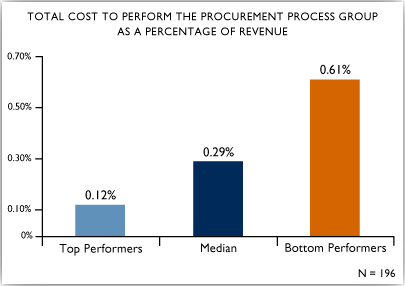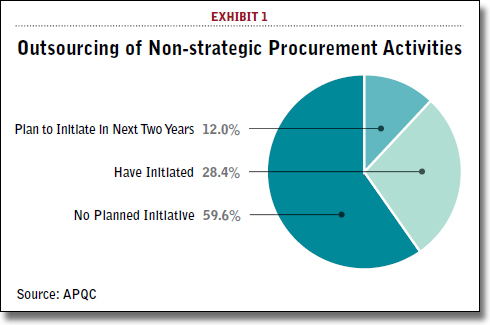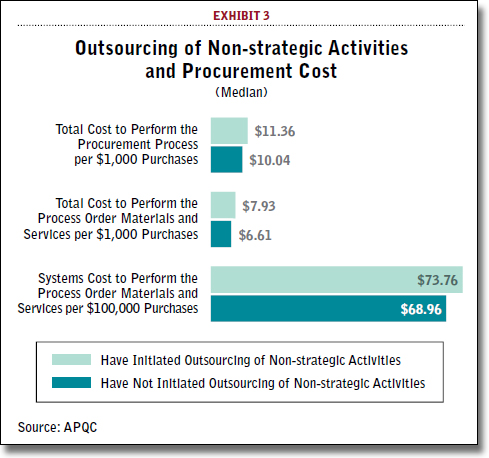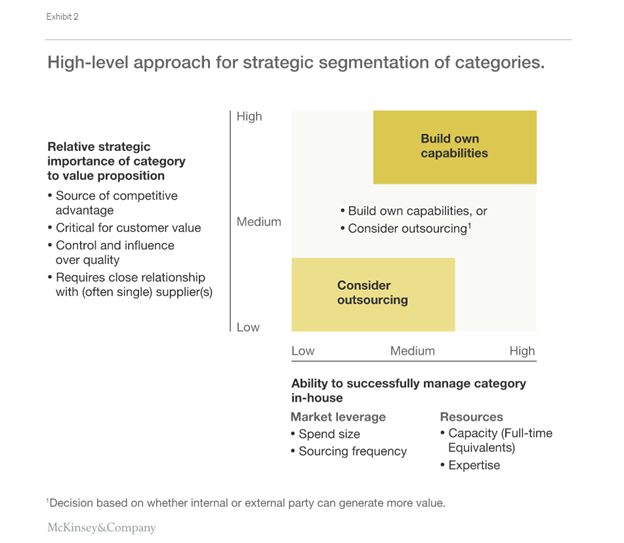It is not uncommon for companies to outsource procurement to third parties. For management teams who see procurement as a clerical function of repetitive tasks, the prima facie appeal of outsourcing is obvious: ostensibly lower transactional costs, lower capital expenditure on procurement systems, greater economies of scale, better procurement process expertise, and greater vertical category knowledge. This appears to be even more logical for indirect spend: all the expenditures laid out for things that enable the business without contributing directly to the production of the good or service the buyer delivers to its own customers.
According to Wise Guy Reports, “In 2018, the global Procurement Outsourcing market size was 2820 million US$ and it is expected to reach 6830 million US$ by the end of 2025, with a CAGR of 11.7% during 2019–2025.”
Before outsourcing, transactions costs alone associated with procurement vary widely between the best and the worst players, per APQC.

Improvement should be about more than just lower transactions costs, though.
Transactions costs do not consider the real cost of poorly executed procurement: overpaying for a second-best solution.
A recent event at the Center for Strategic and International Studies quoted an Accenture study that claimed a 1% improvement in the efficiency of US government outlays with third parties would result in $1 trillion in savings over ten years.
40% of companies have or plan to initiate outsourcing of their “non-strategic” procurement activities.
The real question is, are buyers satisfied with outsourcing?

APQC report that with outsourcing, the buyer can increase the percentage of its spend from vetted suppliers and from suppliers who manage the inventory themselves, although these levels are still low.
However, buyers see no improvement from outsourcing in terms of the percentage of deliveries that take place before the contracted delivery date.
What’s worse is that the transactions cost of purchasing something with an outsourcer are higher than if one were to do it internally.

Outsourcers spend much more on systems than internal procurement organizations.
So, outsourcing really means paying up for better vendor management and transforming capital expenditure from a fixed cost to a variable cost (i.e. one that is embedded in the outsourcer’s ongoing fee).
Of course, one does not need to outsource to improve vendor management and to transform costs. This is easy in a cloud-based world.
What’s worse about outsourcing is that it is not clear that the outsourcer has better (or any real) relationships with the internal strategic customers of the buyer: product management, sales, finance, and the C-suite.
Can an outsourced third party, performing procurement, really understand the buyer’s core business strategy?
If procurement is a strategic activity with meaningful implications for the success or failure of a company’s products that it sells in the marketplace, then is it reasonable to outsource that activity to a third-party?
What if the outsourcer is also performing the same service for a buyer’s competitors? How is the buyer able to differentiate themselves from their principal challengers on the margin?
In fact, it is not difficult to consider how outsourcing projects can run into trouble. McKinsey has a thoughtful piece outlining three of the main ways in which outsourcing procurement can fail, especially when it comes to “the relative strategic importance of category to value proposition.”

Ways in which outsourcing can fail include, but are not limited to:
· poor outsourcer cost control;
· a weak alignment of incentives focused on total savings;
· feeble service;
· a lack of relationship with the internal customers (beyond just procurement, extending to the ultimate beneficiaries in sales, product, finance, etc.);
· and, most importantly, problems with setting specifications and dynamically responding to shifting demand.
What’s more is that scale is not a panacea.
“Scale is only one factor when seeking price reductions, for example. Many companies achieve significant savings through smarter negotiations of strategic importance to their suppliers. Similarly, a company might be able to access favorable prices by joining a purchasing consortium, or reduce labor costs by opening its own service center in a low-cost region.”
Outsourcers will tell you that these issues can be handled by the right service level agreements, but they would say that, wouldn’t they?
The McKinsey article has a couple of anecdotes of service level agreement failure including a contract that paid the outsourcer a percentage of contract value (providing the perverse impetus to inflate costs). The complexity of these arrangements with their implications for other parts of the buyer’s business model make service level agreements very difficult.
A better, or perhaps more updated, version of outsourcing is crowdsourcing procurement, a relatively new concept.
Crowdsourcing generally is defined well by Wikipedia.
“Crowdsourcing is a sourcing model in which individuals or organizations obtain goods and services, including ideas and finances, from a large, relatively open and often rapidly-evolving group of internet users; it divides work between participants to achieve a cumulative result. The word crowdsourcing itself is a portmanteau of crowd and outsourcing, and was coined in 2005. As a mode of sourcing, crowdsourcing existed prior to the digital age (i.e. “offline”).”
“There are major differences between crowdsourcing and outsourcing. Crowdsourcing comes from a less-specific, more public group, whereas outsourcing is commissioned from a specific, named group, and includes a mix of bottom-up and top-down processes. Advantages of using crowdsourcing may include improved costs, speed, quality, flexibility, scalability, or diversity.”
Like so many other techniques, crowdsourcing has become more feasible (and more interesting) as technology has evolved.
“Crowdsourcing is the practice of engaging a ‘crowd’ or group for a common goal — often innovation, problem solving, or efficiency. It is powered by new technologies, social media and web 2.0. Crowdsourcing can take place on many different levels and across various industries.
Thanks to our growing connectivity, it is now easier than ever for individuals to collectively contribute — whether with ideas, time, expertise, or funds — to a project or cause. This collective mobilization is crowdsourcing.”
“This phenomenon can provide organizations with access to new ideas and solutions, deeper consumer engagement, opportunities for co-creation, optimization of tasks, and reduced costs. The Internet and social media have brought organizations closer to their stakeholders, laying the groundwork for new ways of collaborating and creating value together like never before.”
Crowdsourcing in a procurement sense means getting better market intelligence from other buyers, faster. It means getting ready access to a wide variety of suppliers, pre-vetted through a common, shared vendor management system. It means faster cycles, with lower attendant transactions costs, on a cloud-based platform that contemplates no fixed capital expenditure. It means lowering the frictions that keep suppliers from submitting proposals. It includes a 21st-century user interface that invites participation with extremely low implementation and training costs. It makes it easy to involve key business constituencies including finance, sales, and engineering. And it means a business model that is aligned with the interests of both buyers and suppliers.
EdgeworthBox is a platform designed to move procurement with relatively high strategic importance to the buyer into the upper right-hand quadrant of the McKinsey matrix above by increasing massively and inexpensively the ability of the in-house procurement team to run a sourcing process internally, all in a way that brings key constituents from finance, product, sales, and engineering into the RFP conversation. We call it network-based sourcing™. What we deliver is a mechanism for buyers to execute crowdsourced RFPs very quickly.
Let’s schedule a consultation. We’d love to talk to you about RFPs. The doctor is in. Reach out to us at sales@edgeworthbox.com.




